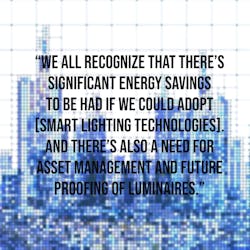As previously reported by LEDs Magazine, the US Department of Energy (DOE) reintroduced the L-Prize competition back in May, with new priorities on efficacy, quality of light, connectivity, lifecycle, and innovation/inclusion. The milestone market-transformation program — launched in 2008 as the Bright Tomorrow Lighting Prize (L-Prize) — helped LED-based replacement lamps to break through development walls, while providing strict lifetime and performance objectives to improve the base of retrofit lamp offerings. Get a brief timeline of the L-Prize history and a fuller description of the current program goals from our prior news story.
The current L-Prize program is targeted at lighting improvements for commercial buildings. This application represents vast opportunity for smart lighting and controls not only in new constructions but also in retrofit campuses where improved technologies can facilitate greater energy efficiency, better space and resource management, and quality lighting evolved to support human visual and non-visual needs in the built environment.
Recently, the Zhaga Consortium and the DALI Alliance jointly announced that the L-Prize evaluation would take into account luminaires that feature compliance with the D4i or Zhaga Book 20 standards — and would award extra points to concept luminaires that feature such standardized data and power connections. The DALI Alliance, a consortium which oversees and promulgates the Digital Addressable Light Interface (DALI) lighting control protocol, provides certification for DALI-2 control devices and the modular D4i approach, which standardizes intra-luminaire interfaces that use DALI-2 technology to connect LED drivers and sensor or connectivity modules. Meanwhile, Zhaga Book 20 specifies the interconnect and the mechanical interface between an indoor LED luminaire and a communication/sensor module in order to support interoperability between devices from various vendors.
LEDs: Hi Adrian, thanks so much for taking time to chat today about the L-Prize, connectivity opportunities, and development leveraging Zhaga Book 20 and the D4i specification. First, could you just give us a quick rundown of your professional background and what your involvement is with the Zhaga Consortium?
Adrian Green: I’m the engineering director for the [Amphenol] Commercial Industrial group in Toronto, and I’ve been with the company for almost 27 years now.
We develop all kinds of different connector solutions, and a few years ago we started getting involved in lighting solutions. So I had joined Zhaga as Amphenol representative a couple years ago, started getting involved with the Zhaga Book 18 as well as Zhaga Book 20, and we helped to develop the interconnect solution that was used in that standard. Over a period of time, the working group chair ended up leaving the group, and I was asked if I would take over the working group chair position, so I agreed to do that a few months ago. So I’ve been acting as working group chair since then.
LEDs: Could you explain what Zhaga Book 20 and the D4i certification from the DALI Alliance offer to product developers? I can point our readers to the column recently written by Zhaga’s Dee Denteneer, but if you were explaining these concepts to someone for the first time, what would you share about the role of these specifications and certifications?
AG: Okay, I guess I can kind of give a little bit of a background to that as well and that there’s some market drivers which have come about which have kind of precipitated the development of D4i, Zhaga Book 20, and also the L-Prize.
Basically, the market adoption of smart lighting technology is still pretty small, relatively speaking, when it comes to commercial installations, as it might be like 1% of installations that are utilizing smart technologies. And it’s not because the technology doesn’t exist. There are ways of being able to have interconnected smart lighting systems, but the adoption rate really isn’t there. Part of the reason for that is there’s a lot of proprietary solutions that are out there, so different companies are pitching their own solutions, and it tends to be very much fragmented as to how people would implement something like this. There’s kind of a reluctance for building managers and so on to be able to lock into a single vendor, right? What happens if that company goes under and then how do they add to their system? You know, how do they interchange or upgrade their modules? ...And so on.
So there’s that side of it, which is that there’s some impediment to the adoption of these smart technologies today. But we all recognize that there’s significant energy savings to be had if we could adopt them. And there’s also a need for asset management and future proofing of luminaires. People want to know: What is the age of my luminaire? How many do we have in total? It would be very useful if they had diagnostic information to know which ones are failing, as opposed to having somebody go around and look for lights that are out and things like that. So there is a need for all that information.
That kind of leads us to a perfect situation where you need a solution to address those impediments that are in the market today. So the DALI Alliance supports the D4i certification part on that. That enables precise, repeatable light-output control in standardized dimming curves using the DALI-2. It helps enable IoT-ready luminaires with the energy and diagnostic data reporting. And it provides color control of lighting systems to be able to have more human-centric lighting, so that it’s helping workers to be productive in their work environments. And it also enables plug-and-play functionality, provided that you have an interconnect solution that is either like a Zhaga Book 18 or a Book 20 interface that could integrate with the LED driver. So that’s the piece of the puzzle that the D4i addresses.
So you’ve got the D4i communication protocol, you’ve got a standardized mechanical form factor for the sensor, and then you’ve got a standardized mating interface that allows you to be able to have plug-and-play functionality from multiple different suppliers, so you’re not locked into a single solution. So if somebody wanted to implement a Zhaga-D4i solution into a building, you would know that you have a path to upgrade the solution. So whether you choose in the beginning to put in a luminaire which is Zhaga Book 20 certified, and perhaps doesn’t have a sensor yet, at some point in the future, if you wanted to add that functionality you know you can.
And you may also start out by implementing some sort of a sensor solution, but perhaps in the future you might want to integrate a networked communication system within your building. You can upgrade the luminaires to be able to do that, provided that there are all D4i-certified components. So that kind of ties together the electrical and the mechanical form factors together in this Zhaga Book 20.
LEDs: In reporting on the DOE’s most recent L-Prize announcement, LEDs Magazine chief editor Maury Wright commented that “since the target is commercial buildings […] the entrants will be working on integral luminaires. And most likely the function that entrants will seek to replace is the troffer widely deployed in office spaces.” Do you think that is a likely development focus? Do you envision a way that Zhaga and D4i can help innovators move beyond the conventional troffer form and function?
AG: I guess a lot depends on the space that it is being looked at. If it’s a smaller conference room, for instance, troffers still might be the right solution, but you can still use a troffer and integrate this Zhaga Book 20 solution, so you can have the communication between different office spaces to link them all together. You can implement different sensor solutions in different workspaces depending on whether you have people using those office rooms. If it’s a conference room, for instance, there’s no point in having lights on if there’s nobody in there, so you could have a presence sensor in that space. The form factor of the lights — I don’t think it is that important. You know, it could be a linear module, or it could be a troffer. The functionality could be exactly the same.
LEDs: The L-Prize competition is encouraging entrants to evolve solid-state lighting (SSL) systems in several areas — efficacy (lm/W), quality of light, connectivity, lifecycle, and innovation/inclusion. How do you see the efforts of Zhaga and the DALI Alliance enabling these improvements or offering resources to tackle the challenges they present?
AG: So yeah, then the most obvious link to what we’re doing is the connectivity portion of it, where that is specifically where the points are awarded for the D4i certification as well as for the Zhaga Book 20.
But there are other areas which overlap with what we’re doing as well. If we look at quality of light, for instance, you know I mentioned the fact that the D4i enables color tuning. So you can definitely use presence sensing, light harvesting, and so on to be able to tune the lighting in a specific space to suit a good healthy work environment, for instance, so it indirectly helps quality of light in what we’re doing.
Directly, it’s related to the connectivity. Product lifecycle is another area where they talk about the overall sustainability of the lighting system and the lifecycle of it. So if you’ve got upgradability built into your lighting system through using the standardized interface, essentially it allows you to be able to maintain using the same luminaire but upgrade the functionality of it at some point in the future. So that’s allowing you — in the past, if you wanted to add some functionality, you probably had to replace the entire luminaire. Now if you are using a standard-compliant luminaire, you can leave that luminaire in there and just simply upgrade either the sensor module or update to a communication module, and then you’ve got that additional functionality without having to get rid of everything.
So yeah, I think we kind of overlap with a couple of areas. When it comes to efficacy and so on, I don’t think it’s necessarily directly related to what we’re doing. And then innovation, inclusion — I think we provide the opportunity for some of the participants at the L-Prize to be able to innovate by utilizing the functionality of the D4i communication protocol to add whatever functionality they may want to come up with in their lighting systems.
LEDs: So in a nutshell, the benefits we have here are:
- Interoperability
- Standardization that allows for future proofing and upgrading
- More sustainability by providing parts that can be changed out — sort of a circular economy type model, yes?
- And then of course the connectivity, which allows for integrated controls functionality but also the capability to change that functionality and make it more flexible depending on the space.
AG: Yes, yes. You got that right.
_
The Zhaga Consortium and the DALI Alliance will explain the standards and how to apply them to the L-Prize concept phase in a joint webinar on Aug. 19, 2021. Those interested in participating in the L-Prize innovation program can find more information and a timeline of the phases at the L-Prize website.
For up-to-the-minute LED and SSL updates, why not follow us on Twitter? You’ll find curated content and commentary, as well as information on industry events, webcasts, and surveys on our LinkedIn Company Page and our Facebook page.







